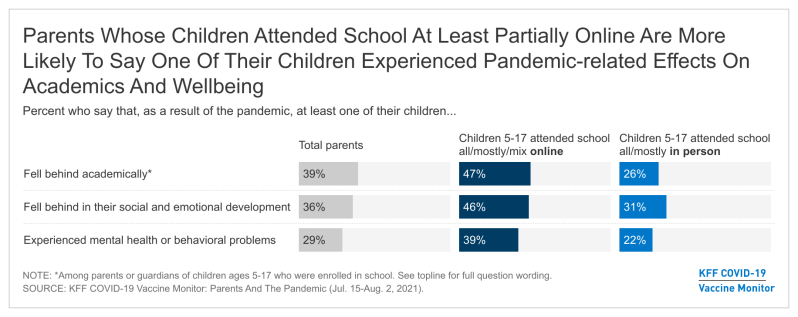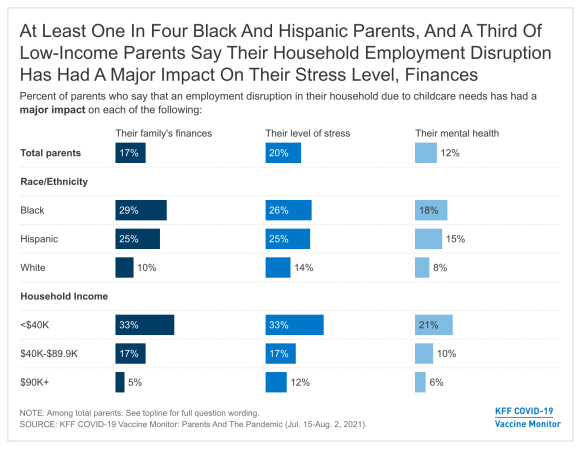Views Of COVID-19 Vaccines Among LGBT Adults
Findings
There has been limited data on how the coronavirus pandemic has impacted the lives of lesbian, gay, bisexual, and transgender individuals (LGBT) in the U.S. Drawing on our previous analyses indicating that LGBT individuals are at greater risk of both COVID-19 health and economic outcomes, this analysis examines their views of the vaccine and their role in uptake.
Key Findings
- This new analysis examines the experiences of LGBT adults from the July COVID-19 Vaccine Monitor and finds that as a group they are more likely to be vaccinated for COVID-19 and less likely to view getting the vaccine as a health risk compared to non-LGBT adults. Previous analyses have found that the LGBT population bears a disproportionate burden from the pandemic, including economic hardships and mental health problems. In addition, research has found that LGBT individuals have higher rates of comorbidities and experience stigma and discrimination in the health system.
- A larger share of LGBT adults than non-LGBT adults say they have received at least one dose of a COVID-19 vaccine (82% vs 66%) and 8 in 10 report being fully vaccinated (80% with one of their one-dose vaccine or two of their two-dose). This may reflect the fact that larger shares of LGBT adults identify as Democrats, a group that has been disproportionately likely to get the vaccine. However, the high level of vaccination among LGBT adults is notable given that they are a younger population. Nearly half (45%) of LGBT adults are under age 30, an age group that has lagged in vaccination rates compared to older populations.
- LGBT adults are more supportive of vaccine mandates than non-LGBT adults. Almost two-thirds of LGBT people (65%) support the federal government recommending that employers require their employees to get the COVID-19 vaccine unless they have a medical exception. Fewer non-LGBT adults agree with government recommended mandates, with the group split between supporting them (50%) and not (47%). Again, this likely reflects the differences in partisan identification between the two populations.
- A larger share of LGBT people than non-LGBT people believe the seriousness of the pandemic has been generally underestimated by the media, which may be a reflection of the disproportionate mental health and economic struggles they have faced. This may also be a factor in their relative enthusiasm and high uptake of the COVID-19 vaccine. Compared to other historically marginalized groups that have tended to have lower vaccine uptake, this high level of vaccination could be an important factor to mitigate further disparities in the pandemic’s impact on the LGBT population.
COVID-19 Vaccination Intentions And Uptake
As of July 2021, eight in ten LGBT adults report being vaccinated for COVID-19, according to the latest KFF COVID Vaccine Monitor. A larger share of LGBT adults report receiving at least one dose of a COVID-19 vaccine than non-LGBT adults (82% vs. 66%). Eight in ten report being fully vaccinated (80% with one of their one-dose vaccine or two of their two-dose). Eighteen percent (18%) of LGBT adults remain unvaccinated, a smaller share than for non-LGBT adults, 32% of whom remain unvaccinated.
Among LGBT adults, a small share (2%) say they want to get vaccinated “as soon as possible,” while 4% want to “wait and see” before getting vaccinated, and 12% say they will “definitely not” get the vaccine (similar to the 14% of non-LGBT adults who express this view).
In KFF’s analysis of April and May polling data, 56% of LGBT adults reported being vaccinated, 5% wanted to get one “as soon as possible,” and another 20% wanted to “wait and see,” mostly matching the reported intentions among the general public, 59% of whom were already vaccinated, 6% wanted it right away, and 14% were “wait and see.” Around 1 in 10 LGBT people reported they definitely would not get vaccinated (11%) or would only get it if required (7%), also similar to intentions among the general population.
Now however, a larger share of LGBT adults report being vaccinated, surpassing rates among the non-LGBT population.
A previous KFF analysis examined the demographic groups among the unvaccinated population finding adults who are still unvaccinated tend to be older, more Republican-leaning, less educated, and lower income, with each of those groups making up a larger part of unvaccinated than the vaccinated group. Party identification, in particular, tends to be a strong predictor of vaccination intentions.
Higher rates of vaccination among LGBT adults compared to their non-LGBT peers may be associated with strong Democratic party identification, rather than or in addition to, sexual orientation or gender identity. Two-thirds of LGBT adults identify as Democrats or lean that way compared to 43% of non-LGBT adults. By contrast, more than a third (36%) of non-LGBT adults identify or lean Republican compared to 14% of LGBT adults. Additionally, LGBT adults tend to be younger and lower income, two groups that tend to have low vaccination rates. Almost half (45%) of adults who identify as LGBT are under age 30 compared to 19% of non-LGBT adults, and half (51%) of LGBT adults compared to a third (34%) of non-LGBT people report having household incomes under $40,000. High self-reported vaccination rates among LGBT people could be driven by their Democratic partisanship, but also is in spite of their relatively young age and lower incomes.
Views of covid-19 and the vaccine
In addition to higher vaccination uptake, LGBT individuals have different views of how the media has portrayed the severity of the pandemic, as well as the relative risk of the vaccines versus the virus.
Three in 10 (31%) LGBT adults say what is said in the news “generally underestimates” the seriousness of the pandemic compared to one in five (18%) non-LGBT adults. Another four in ten LGBT adults (40%) say the news is “generally correct” in its portrayal of the seriousness of the pandemic, which is similar to the share of non-LGBT adults who report the same (44%).
Consistent with views of the pandemic generally, a large majority of LGBT adults say becoming infected with coronavirus is a bigger risk to their health than getting vaccinated (82%), while 14% think getting vaccinated is a bigger risk. About 7 in 10 (69%) non-LGBT people agree that becoming infected is a bigger risk, though this share is somewhat less than among the LGBT group.
Similar to other adults, LGBT people generally have high levels of confidence in the effectiveness of the COVID-19 vaccines. Two-thirds of LGBT people think the available COVID-19 vaccines are “extremely” or “very” effective at preventing vaccinated individuals from getting seriously sick or hospitalized if infected (67%) and dying from COVID (66%). Another 56% say the vaccines are effective at preventing infection if exposed to someone who is sick and 45% say the same of passing coronavirus on to others.
Mandates
LGBT adults are more supportive of vaccine mandates than non-LGBT adults. Almost two-thirds (65%) of LGBT people support the federal government recommending that employers require their employees to get the COVID-19 vaccine, unless they have a medical exemption. Fewer non-LGBT adults agree with the government recommended mandates, with the group split between supporting them (50%) and not (47%). Given that views on government mandates divide sharply along partisan lines, this division of opinion between LGBT adults and non-LGBT adults likely reflects the fact that LGBT adults lean more Democratic, as noted above.
Methodology
This KFF COVID-19 Vaccine Monitor was designed and analyzed by public opinion researchers at the Kaiser Family Foundation (KFF). The survey was conducted July 15-July 27, 2021, among a nationally representative random digit dial telephone sample of 1,517 adults ages 18 and older (including interviews from 322 Hispanic adults and 300 non-Hispanic Black adults), living in the United States, including Alaska and Hawaii (note: persons without a telephone could not be included in the random selection process). This includes 95 adults who identify as LGBT, 1,403 who are not LGBT, and 19 respondents who said they didn’t know or refused to answer. Phone numbers used for this study were randomly generated from cell phone and landline sampling frames, with an overlapping frame design, and disproportionate stratification aimed at reaching Hispanic and non-Hispanic Black respondents as well as those living in areas with high rates of COVID-19 vaccine hesitancy. Stratification was based on incidence of the race/ethnicity subgroups and vaccine hesitancy within each frame. High hesitancy was defined as living in the top 25% of counties as far as the share of the population not intending to get vaccinated based on the U.S. Census Bureau’s Household Pulse Survey. The sample also included 28 respondents reached by calling back respondents that had previously completed an interview on the KFF Tracking poll at least nine months ago. Another 118 interviews were completed with respondents who had previously completed an interview on the SSRS Omnibus poll (and other RDD polls) and identified as Hispanic (n =50 ; including 21 in Spanish) or non-Hispanic Black (n=68). Computer-assisted telephone interviews conducted by landline (176) and cell phone (1,341, including 1,015 who had no landline telephone) were carried out in English and Spanish by SSRS of Glen Mills, PA. To efficiently obtain a sample of lower-income and non-White respondents, the sample also included an oversample of prepaid (pay-as-you-go) telephone numbers (25% of the cell phone sample consisted of prepaid numbers) Both the random digit dial landline and cell phone samples were provided by Marketing Systems Group (MSG). For the landline sample, respondents were selected by asking for the youngest adult male or female currently at home based on a random rotation. If no one of that gender was available, interviewers asked to speak with the youngest adult of the opposite gender. For the cell phone sample, interviews were conducted with the adult who answered the phone. KFF paid for all costs associated with the survey.
The combined landline and cell phone sample was weighted to balance the sample demographics to match estimates for the national population using data from the Census Bureau’s 2019 U.S. American Community Survey (ACS), on sex, age, education, race, Hispanic origin, and region, within race-groups, along with data from the 2010 Census on population density. The sample was also weighted to match current patterns of telephone use using data from the January- June 2020 National Health Interview Survey. The weight takes into account the fact that respondents with both a landline and cell phone have a higher probability of selection in the combined sample and also adjusts for the household size for the landline sample, and design modifications, namely, the oversampling of potentially undocumented respondents and of prepaid cell phone numbers, as well as the likelihood of non-response for the re-contacted sample. All statistical tests of significance account for the effect of weighting.
The margin of sampling error including the design effect for the full sample is plus or minus 3 percentage points. Numbers of respondents and margins of sampling error for key subgroups are shown in the table below. For results based on other subgroups, the margin of sampling error may be higher. Sample sizes and margins of sampling error for other subgroups are available by request. Sampling error is only one of many potential sources of error and there may be other unmeasured error in this or any other public opinion poll. Kaiser Family Foundation public opinion and survey research is a charter member of the Transparency Initiative of the American Association for Public Opinion Research.
This work was supported in part by grants from the Chan Zuckerberg Initiative DAF (an advised fund of Silicon Valley Community Foundation), the Ford Foundation, and the Molina Family Foundation. We value our funders. KFF maintains full editorial control over all of its policy analysis, polling, and journalism activities.
| Group | N (unweighted) | M.O.S.E. |
| Total | 1,517 | ± 3 percentage points |
| LGBT Status | ||
| LGBT adults | 95 | ± 13 percentage points |
| Non-LGBT adults | 1,403 | ± 3 percentage points |



































